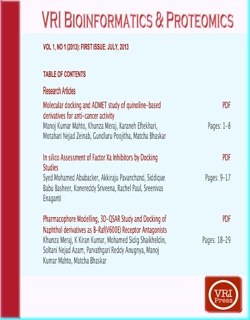
In silico Assessment of Factor Xa Inhibitors by Docking Studies
Abstract
Human Factor Xa (FXa), a blood coagulation enzyme which catalyses the activation of prothrombin to thrombin and plays a pivot role in haemostasis and thrombosis. Imbalance in the activation of this enzyme disturbs the normal haemostasis leading to bleeding disorders and also vascular occlusion with overproduction of thrombin. This intravascular clot formation causes many cardiovascular diseases such as acute myocardial infarction (AMI), stroke, pulmonary embolism (PE), and deep vein thrombosis (DVT). So the direct inhibition of FXa may contribute for developing effective and safe anticoagulants without effecting thrombin activity necessary for normal hemostasis. The present study initiates to provide insight of FXa inhibition and facilitate the design of more potent ligands , a series of Sulfonamide and Thiophene-Anthranilamide derivatives are docked to the X-ray structure of FXa(2P95) using Discovery Studio(DS), and their binding conformations are analyzed. The docking analysis shows the compound 1v (2-(5-Chloro-2-thienyl)-N-{(3S)-1-[(1S)-1-methyl-2-(4-morpholinyl)-2-oxoethyl]-2-oxo-3-pyrrolidinyl}-1,3-thiazole-5-sulfonamide) of sulfonamide derivatives and 12b(3-Chloro-N-[4-chloro-2-[[(5-chloro-2-pyridinyl)amino]carbonyl]-6-methoxyphenyl]-4-[[methyl(methylsulfonyl)amino]methyl]-2-thiophenecarboxamide)of Thiophene-Anthranilamides are having a high dock score of 55.722K.Cal/mol and 57.523 K.Cal/mol respectively, may act as potent inhibitors of FXa for the development of antithrombotic drugs.
Â
Â
Keywords
Full Text:
PDFReferences
Zhu B-Y, Scarborough RM: . Factor Xa inhibitors: Recent advances in anticoagulant agents. Annual Reports in Medicinal Chemistry 2000, 35:83-102.
http://dx.doi.org/10.1016/S0065-7743(00)35010-2
Komiyama Y, Pedersen AH, Kisiel W: Proteolytic activation of human factors IX and X by recombinant human factor VIIa: effects of calcium, phospholipids, and tissue factor. Biochemistry 1990, 29:9418-9425.
http://dx.doi.org/10.1021/bi00492a016
PMid:2248955
Linkins, L. A. and J. I. Weitz (2003). "New anticoagulants." Semin Thromb Hemost 29(6): 619-631.
http://dx.doi.org/10.1055/s-2004-815629
PMid:14719178
Harder S, Thürmann P: Clinically important drug interactions with anticoagulants. An update. Clinical pharmacokinetics 1996, 30:416-444.
http://dx.doi.org/10.2165/00003088-199630060-00002
PMid:8792056
Hirsh J: Oral anticoagulant drugs. The New England journal of medicine 1991, 324:1865.
http://dx.doi.org/10.1056/NEJM199106273242606
PMid:1801769
Wells PS, Holbrook AM, Crowther NR, Hirsh J: Interactions of warfarin with drugs and food. Annals of internal medicine 1994, 121:676-683.
http://dx.doi.org/10.7326/0003-4819-121-9-199411010-00009
PMid:7944078
Borensztajn K, Spek CA: Blood coagulation factor Xa as an emerging drug target. Expert opinion on therapeutic targets 2011, 15:341-349.
http://dx.doi.org/10.1517/14728222.2011.553608
PMid:21250873
Vaghy PL, McKenna E, Itagaki K, Schwartz A: Resolution of the identity of the Ca< sup> 2+-antagonist receptor in skeletal muscle. Trends in pharmacological sciences 1988, 9:398-402.
http://dx.doi.org/10.1016/0165-6147(88)90066-1
Hondeghem L, Katzung B: Antiarrhythmic agents: the modulated receptor mechanism of action of sodium and calcium channel-blocking drugs. Annual review of pharmacology and toxicology 1984, 24:387-423.
http://dx.doi.org/10.1146/annurev.pa.24.040184.002131
PMid:6203481
Gupta, Satya P. "Quantitative structure-activity relationships of cardiotonic agents." Progress in drug research. Birkhäuser Basel, 2000. 235-282. APA
PMid:11127965
Mann KG, Butenas S, Brummel K: The dynamics of thrombin formation. Arteriosclerosis, thrombosis, and vascular biology 2003, 23:17-25.
http://dx.doi.org/10.1161/01.ATV.0000046238.23903.FC
PMid:12524220
Triggle DJ, Langs DA, Janis RA: Ca2+ channel ligands: Structureâ€function relationships of the 1, 4â€dihydropyridines. Medicinal research reviews 1989, 9:123-180.
http://dx.doi.org/10.1002/med.2610090203
PMid:2654521
Corelli F, Manetti F, Tafi A, Campiani G, Nacci V, Botta M: Diltiazem-like Calcium Entry Blockers: A Hypothesis of the Receptor-Binding Site Based on a Comparative Molecular Field Analysis Model. Journal of Medicinal Chemistry 1997, 40:125-131.
http://dx.doi.org/10.1021/jm9605647
PMid:9016337
Jenny N, Mann K: Coagulation cascade: an overview. Thrombosis and Hemorrhage. Baltimore: Williams and Wilkins 1998:3-27.
Leadley J: Coagulation factor Xa inhibition: biological background and rationale. Current topics in medicinal chemistry 2001, 1:151-159.
http://dx.doi.org/10.2174/1568026013395380
PMid:11899250
Babine RE, Bender SL: Molecular recognition of protein-ligand complexes: applications to drug design. Chemical reviews 1997, 97:1359-1472.
http://dx.doi.org/10.1021/cr960370z
PMid:11851455
Cooper D, Millar D, Wacey A, Pemberton S, Tuddenham E: Inherited factor X deficiency: molecular genetics and pathophysiology. Thrombosis and haemostasis 1997, 78:161-172.
PMid:9198147
DOI: http://dx.doi.org/10.14259%2Fbp.v1i1.43
Refbacks
- There are currently no refbacks.








